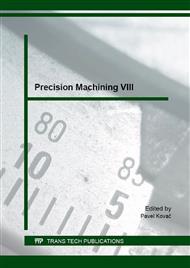[1]
S. Palanisamy, S.D. McDonald, M.S. Dargush, Effects of coolant pressure on chip formation while turning Ti6AlV alloy, Int. Journal of Machine tools&manufacture 49 (2009) 739-743.
DOI: 10.1016/j.ijmachtools.2009.02.010
Google Scholar
[2]
B. Słodki, W. Zębala, G. Struzikiewicz, Correlation Between Cutting Data Selection and Chip Form in Stainless Steel Turning, Machining Science and Technology 19, 2 ( 2015) 217-235. DOI: 10. 1080/10910344. 2015. 1018530.
DOI: 10.1080/10910344.2015.1018530
Google Scholar
[3]
R. Maruda, S. Legutko, G. Krolczyk, P. Raos, Influence of cooling conditions on the machining process under MQCL and MQL conditions, Tehnicki Vjesnik – Technical Gazette, 22 (4) (2015) 965-970.
DOI: 10.17559/tv-20140919143415
Google Scholar
[4]
W. Zębala, M. Plaza, Comparative study of 3-and 5-axis CNC centers for free-form machining of difficult-to-cut material, International Journal of Production Economics, 158 (2014) 345-358.
DOI: 10.1016/j.ijpe.2014.08.006
Google Scholar
[5]
AG. Mamalis, J. Kundrak J, M. Horvath, On a novel tool life relation for precision cutting tools, Journal of Manufacturing Science and Engineering - Transactions of the Asme 127, 2 (2005) 328-332.
DOI: 10.1115/1.1794158
Google Scholar
[6]
B. Mikó, J. Beňo, Effect of the Working Diameter to the Surface Quality in Free-form Surface Milling, Key Engineering Materials 581 (2014) 372-377.
DOI: 10.4028/www.scientific.net/kem.581.372
Google Scholar
[7]
W. Zębala, B. Słodki, G. Struzikiewicz, Productivity and reliability improvement in turning inconel 718 alloy - case study, Eksploatacja i Niezawodnosc-Maintenance and Reliability 15, 4 (2013) 421-426.
Google Scholar
[8]
B. Karpuschewski, K. Schmidt, J. Prilukova, J. Beňo, I. Maňková, N. Hieu, Influence of tool edge preparation on performance of ceramic tool inserts when hard turning, Journal of Materials Processing Technology 213, 11 (2013) 1978-(1988).
DOI: 10.1016/j.jmatprotec.2013.05.016
Google Scholar
[9]
W. Zębala, R. Kowalczyk, Cutting Data Influence on Cutting Forces and Surface Finish During Sintered Carbide Turning, Key Engineering Materials 581 (2014) 148-153.
DOI: 10.4028/www.scientific.net/kem.581.148
Google Scholar
[10]
J. Kundrák, G. Varga, Possibility of reducing environmental load in hard machining. Key Engineering Materials 496 (2011) 205-210.
DOI: 10.4028/www.scientific.net/kem.496.205
Google Scholar
[11]
SANDVIK Coromant - Application Guide: Aerospace Engine (2004).
Google Scholar
[12]
B. Karpuschewski, K. Schmidt, J. Beňo, I. Maňková, J. Prilukova, Measuring procedures of cutting edge preparation when hard turning with coated ceramics tool inserts, Measurement 55, 9 (2014) 627-640.
DOI: 10.1016/j.measurement.2014.06.008
Google Scholar
[13]
R. Maruda, E. Feldshtein, S. Legutko, G.M. Krolczyk, Analysis of contact phenomena and heat exchange in the cutting zone under Minimum Quantity Cooling Lubrication conditions, The Arabian Journal for Science and Engineering (2015).
DOI: 10.1007/s13369-015-1726-6
Google Scholar
[14]
W. Zębala, Tool stiffness influence on the chosen physical parameters of the milling process, Bulletin of the Polish Academy of Science - Technical Sciences 60/3 (2012) 597-604, DOI: 10. 2478/v10175-012-0071-0.
DOI: 10.2478/v10175-012-0071-0
Google Scholar
[15]
Sandvik Coromant - Application Guide: Stainless Steel Turning(1997), High pressure coolant machining (2014), Turning tools catalogue (2014).
Google Scholar
[16]
W. Zębala, B. Słodki, Cutting data correction in Inconel 718 turning, International Journal of Advanced Manufacturing Technology 65, 5-8 (2013) 881-893, DOI 10. 1007/s00170-012-4225-x.
DOI: 10.1007/s00170-012-4225-x
Google Scholar
[17]
W. Zębala, R. Kowalczyk, Estimating the effect of cutting data on surface roughness and cutting force during WC-Co turning with PCD tool using Taguchi design and ANOVA analysis, International Journal of Advanced Manufacturing Technology, 77, 9-12 (2015).
DOI: 10.1007/s00170-014-6382-6
Google Scholar
[18]
C. Felho, J. Kundrák, Characterization of topography of cut surface based on theoretical roughness indexes, Key Engineering Materials 496 (2011) 194-199.
DOI: 10.4028/www.scientific.net/kem.496.194
Google Scholar
[19]
J. Beňo, I. Maňková, M. Vrabeľ, D. Kottfer, Roughness measurement methodology for selection of tool inserts, Measurement 46, 1 (2013) 582-592.
DOI: 10.1016/j.measurement.2012.08.017
Google Scholar


